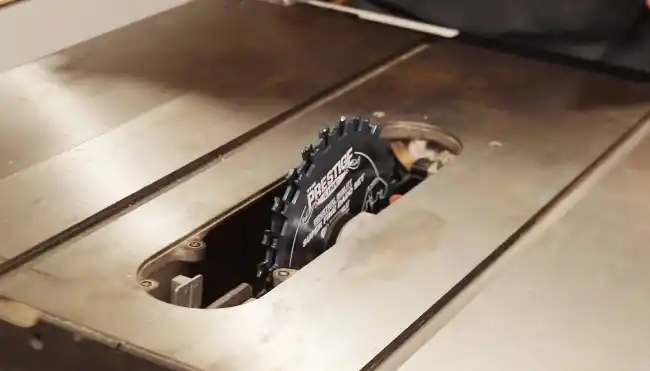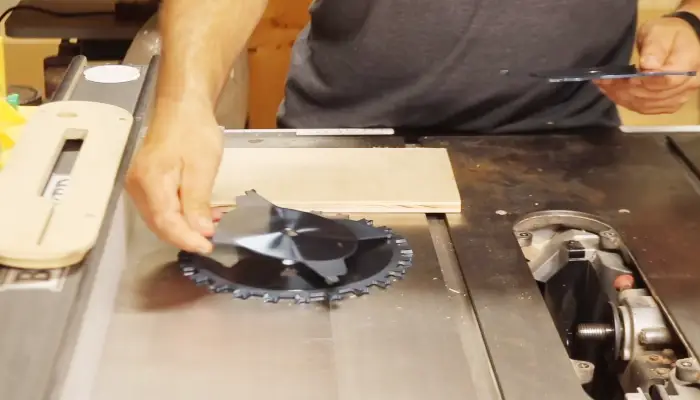Can You Put Two Blades on a Table Saw: 8 Reasons to Avoid
In woodworking, there are times when you might need to make wider cuts or create custom dado sets. At this point, you may have considered using two blades on your table saw. However, can you really put two blades on a table saw, and is it a safe and recommended approach?
According to my research, using two blades on a table saw is possible but generally not recommended. I found that many seasoned woodworkers consider using two blades when a wider cut is required.
However, several safety concerns exist, including torque issues, chip clearance, and the risk of blades touching during operation.
I will describe why it is best to avoid placing two blades on a table saw, as well as what factors you should consider when contemplating using two blades on a table saw.
Why Shouldn’t You Put Two Blades on a Table Saw

Placing two blades on a table saw can lead to several issues that should be avoided, such as:
- Risk of blade kerfs touching
- Torque and power limitations
- Inadequate chip clearance
- Balance issues
- Insufficient blade clearances
- Heat buildup
- Inconsistent cutting speed
- Reduced blade longevity
Now, explore each compelling reason why putting two blades on a table saw is generally not advisable.
1. Risk of Blade Kerfs Touching
Placing two blades on a table saw increases the risk of the blade kerfs touching, which can lead to various issues and compromise both cutting accuracy and safety.
When the kerfs of the blades touch, it can cause them to bind, leading to kickback or a sudden and violent backward movement of the workpiece. This can result in serious injury to the operator and damage to the equipment.
2. Torque and Power Limitations
Running two blades concurrently on a table saw can exceed the torque capabilities and power limitations of the tool, compromising its performance and potentially causing damage.
Table saws are designed with specific torque requirements to handle the load of a single blade. When two blades are used simultaneously, the motor has to work harder to power both blades, resulting in increased torque demands. This excessive torque can strain the motor, decrease performance, and even motor failure.
3. Inadequate Chip Clearance
Using two blades on a table saw can result in sawdust accumulation between the blades. This accumulation can impede the cutting process and adversely affect the quality of the cut.
When the sawdust builds up between the blades, it can cause the blades to bind or even kick back, resulting in potential safety hazards.
Additionally, the lack of adequate chip clearance can cause the sawdust to be ejected in unpredictable directions, posing a risk to the operator and anyone in the vicinity.
Therefore, it’s crucial to avoid using two blades on a table saw to ensure proper chip clearance and maintain a safe working environment.
4. Balance Issues
You should avoid using two blades on a table saw because it can create balance issues. When two blades are placed on a table saw, it’s crucial for them to be perfectly balanced.
Even a slight imbalance can cause the blades to vibrate, resulting in a less accurate cut. This can be particularly problematic when working with delicate or intricate materials.
Additionally, the vibration caused by an imbalanced setup can cause damage to both the blades and the table saw itself over time.
5. Insufficient Blade Clearances
Insufficient blade clearances can cause significant safety risks and compromise the quality of your cuts when attempting to place two blades on a table saw. Proper clearance between the teeth of each blade is crucial to prevent binding or catching on the material being cut.
When two blades are used simultaneously, there’s a higher chance of the teeth interfering with each other, leading to potential accidents and damage to the workpiece. The lack of sufficient clearance can result in the blades getting jammed, causing kickbacks or even throwing the material back at the operator.
Moreover, inadequate clearance can also result in poor quality cuts, as the blades may struggle to cut through the material effectively, leading to uneven or rough edges.
6. Heat Buildup
The use of two blades increases the friction generated during operation, which in turn leads to a buildup of heat. This elevated heat can have detrimental effects on the blades themselves, compromising their quality and overall performance.
Moreover, the excess heat can pose a significant fire hazard in the workshop, especially when combined with combustible materials such as sawdust or wood chips. It’s essential to prioritize safety in the workshop and adhere to the manufacturer’s guidelines for the proper use of table saws.
Avoiding the operation of a table saw with two blades is a prudent decision to prevent heat buildup and mitigate potential fire risks.
7. Inconsistent Cutting Speed

Inconsistent cutting speeds can arise when using two blades due to variations in the manufacturing process or wear and tear. The blades may not rotate at exactly the same speed, leading to uneven cuts and a lack of uniformity in the final woodworking project.
These variations in cutting speed can result in one blade cutting faster or slower than the other, causing the wood to be pushed or pulled in different directions. This can result in jagged edges, splintering, and an overall poor-quality finish.
8. Reduced Blade Longevity
Using two blades on a table saw significantly shortens the lifespan of the blades due to increased wear and tear. When two blades are used simultaneously, the cutting action is intensified, causing more friction. This heightened stress on the blades leads to accelerated dulling and faster deterioration.
As a result, the blades may wear out faster, requiring frequent replacements. This not only incurs additional costs but also consumes valuable time. Moreover, the use of two blades can cause the saw motor to work harder, potentially leading to overheating and damage to the motor itself.
Factors to Consider When Contemplating the Use of Two Blades on a Table Saw
After knowing the potential risks associated with using two blades on a table saw, it’s crucial to consider several key factors if you want to explore this approach.
1. Blade Compatibility
Before attempting to use two blades on a table saw, it is crucial to ensure that they are compatible with each other. When contemplating the use of two blades, there are several factors to consider. The blades should have similar diameters to maintain balance and prevent vibration during operation.
Additionally, teeth configurations should match to ensure consistent and smooth cutting. Mismatched teeth can lead to uneven cuts and potential damage to the material being worked on.
Also, the arbor hole sizes must be compatible with the arbor shaft of the table saw. A mismatch in arbor hole sizes can result in unstable blade mounting and potential accidents.
In addition to ensuring compatibility between the two blades, using a table saw splitter or a riving knife is crucial when using multiple blades. These safety devices are designed to prevent kickback, a dangerous situation where the workpiece is forcefully thrown back toward the operator.
2. Material to Be Cut
When considering the use of two blades on a table saw, it’s imperative to assess the characteristics of the material you intend to cut. Different materials exhibit varying densities, hardness, and compositions, which significantly influence the safety and performance of dual blades.
For instance, softwoods like pine or cedar are generally more accommodating for a dual-blade setup due to their easier-cutting nature. Conversely, hardwoods such as oak or maple pose greater challenges, demanding heightened precision and control when using two blades simultaneously.
Moreover, when cutting MDF (medium-density fiberboard) or plywood, it’s essential to consider their layered compositions. These materials may have different layers or compositions, potentially impacting the cutting process.
Considering these factors is crucial to ensure the appropriateness and safety of employing two blades on a table saw for your specific working material.
3. Trial Runs and Testing
When assessing the feasibility of using two blades on a table saw, conducting trial runs and testing with scrap material is crucial to ensure optimal performance and safety.
Before committing to a full project, it’s important to understand how the table saw will handle the additional blade and whether any adjustments need to be made.
Start by selecting a piece of scrap material that closely resembles the material you plan to cut. Install the two blades securely and make sure they’re aligned properly.
Then, make a series of test cuts, paying close attention to the cuts’ quality, the saw’s power, and any potential issues such as excessive vibration or overheating.
Based on the results of your trial runs and testing, you can determine whether using two blades on your table saw is a viable option for your specific needs.
Can you use a wobble Dado adapter to make wider cuts on your table saw?

You can use a table saw wobble dado adapter to make wider cuts, but it’s important to recognize its limitations. Although a wobble dado blade can create a coved bottom dado, achieving 3/4″ or wider widths may result in accuracy issues due to the wobbling motion introducing variability.
In such cases, it’s recommended to explore alternatives like a stacked dado set or other purpose-built tools that offer better control and consistency for achieving accurate and clean cuts in various woodworking projects.
Can round stock be safely cut using a table saw?
Using a table saw to cut round stock is not recommended. Ripping round stock on a table saw is generally unsafe due to the risk of binding and kickback. The miter gauge should not be used with the fence when cutting round stock, as this increases the likelihood of the blade binding, leading to potential kickback.
It’s crucial to prioritize safety and explore alternative tools or methods, such as a bandsaw or a lathe, which are better suited for cutting and shaping round stock without compromising safety.
Ensuring Safe Practices When Using a Table Saw
It is now clear that using two blades on a table saw poses significant risks and challenges, as I shared with you the potential issues.
It can cause blade kerfs to touch, torque and power limitations, and inadequate chip clearance. Also, balance issues, insufficient blade clearances, heat buildup, inconsistent cutting speeds, and shorter blade life.
These factors highlight the importance of prioritizing safety and considering alternative methods or purpose-built tools for specific woodworking tasks. In your woodworking endeavors, choosing safer options when using a power saw ensures the quality of your work and your well-being in the workshop.







